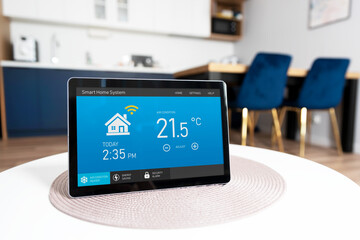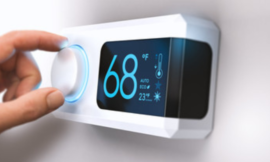Make your AC smarter with Smart Switches for AC—from remote control to energy monitoring, enjoy flexibility and cost savings with every switch.

Home automation systems have come a long way since their inception, constantly evolving to meet the needs and demands of modern living. A recent breakthrough in this field is the emergence of smart switches for AC, which are revolutionizing the way we control and manage our air conditioning units.
These sophisticated devices are reshaping the future of home automation by offering enhanced energy efficiency, improved convenience, and seamless integration with other smart home devices.
Understanding Smart Switches for AC
What are smart switches for AC?
Smart switches for AC are advanced control devices that allow users to remotely manage and monitor their air conditioning units using wireless technology.
These switches are designed to replace traditional switches and add intelligent functionality to the AC system. They enable users to control various settings, such as temperature, fan speed, and mode, from anywhere within the range of their home network.
How do smart switches work?
Smart switches for AC utilize a combination of Wi-Fi or Bluetooth connectivity and sensors to communicate with the air conditioning unit.
They are typically installed in place of traditional switches and connect to the AC unit, enabling users to control and monitor it through a dedicated mobile app or compatible smart home devices.
These switches can also collect data about energy usage, temperature patterns, and user preferences, allowing for personalized and automated scheduling.
Types of smart switches available in the market
The market offers a variety of smart switches for AC, each with its own unique features and capabilities. Some switches are designed for specific AC models or brands, while others offer universal compatibility.
Additionally, there are switches that support voice control through virtual assistants, while others prioritize energy efficiency or integrate with existing home automation systems.
Users can choose the type that best fits their requirements and enhances their desired functions.
Advantages of Smart Switches for AC
- Energy efficiency and cost savings: Smart switches for AC contribute significantly to energy efficiency by allowing users to optimize cooling settings and create schedules tailored to their lifestyle. By ensuring that the AC unit operates only when needed, these switches help reduce energy consumption and lower utility bills. They also provide real-time energy usage data, enabling users to identify and address unnecessary energy waste.
- Improved convenience and comfort: Gone are the days of walking to the AC unit to adjust the temperature manually. Smart switches offer the convenience of controlling the AC system from anywhere within the range of the home network. Whether users are lying on the couch or outside the house, they can easily adjust the settings using their smartphones or voice commands. This level of convenience translates to enhanced comfort and a more seamless living experience.
- Integration with other smart home devices: One of the key advantages of smart switches for AC is their ability to integrate with other smart home devices. This integration allows for centralized control and automation of various aspects of the home, creating a cohesive ecosystem. For example, users can synchronize the operation of their AC unit with window blinds, lighting systems, or occupancy sensors, optimizing overall energy efficiency and creating a truly smart environment.
- Remote access and control: With smart switches, gone are the days of worrying about whether the AC was left on before leaving the house. These switches enable remote access and control through dedicated mobile apps or compatible smart home devices. Users can turn the AC on or off, adjust settings, or create schedules even when they are miles away. This feature provides peace of mind and ensures energy-efficient usage, even in unpredictable situations.
Smart Switch Features and Functionality
Smart switches for AC come loaded with various features and functionalities that enhance their performance and user experience. Let’s explore some of the key features:
Voice control through virtual assistants
Many smart switches offer voice control capabilities through popular virtual assistants like Amazon Alexa, Google Assistant, or Apple Siri.
This feature allows users to control their AC unit using simple voice commands, adding an extra layer of convenience and eliminating the need to physically interact with the switch or the mobile app.
Scheduling and automation capabilities
Smart switches empower users to create custom schedules, automating the operation of their AC unit based on personal preferences.
For example, users can set the switch to turn on the AC unit automatically half an hour before they arrive home or schedule it to turn off during specific hours when no one is present.
These scheduling and automation capabilities ensure optimized energy usage and personalized comfort.
Energy usage monitoring and analysis
A standout feature of smart switches for AC is their ability to monitor and analyze energy usage patterns.
They provide valuable insights into energy consumption, enabling users to make informed decisions about their cooling habits and identify opportunities for energy-saving improvements. Some switches even offer energy reports, displaying usage trends and suggesting ways to minimize waste.
Compatibility with different AC models and brands
Smart switches for AC have evolved to support compatibility with a wide range of AC models and brands, ensuring that users have multiple options to choose from.
Whether you have a split AC, window AC, or central AC system, there is likely a smart switch available to seamlessly integrate with your existing setup. The compatibility ensures that users can enjoy the benefits of smart automation regardless of their AC unit type.
Installation and Setup Process
Professional installation vs. DIY
The installation of smart switches for AC can be done either professionally or as a do-it-yourself (DIY) project. Professional installation involves hiring an expert who replaces traditional switches with smart ones and ensures proper connectivity.
On the other hand, DIY installation requires users to follow the provided instructions and replace the switches themselves. The choice between professional installation and DIY depends on the user’s technical skills, comfort level, and time availability.
Step-by-step guide for self-installation
If you choose to embark on a self-installation project, follow these steps to set up your smart switch for AC:
- Turn off the power. Begin by switching off the power supply to the AC unit from the circuit breaker to avoid any electrical hazards.
- Remove the traditional switch: Carefully remove the existing switch cover plate and unscrew the screws holding the switch in place. Gently pull the switch forward, disconnecting the wires attached to it.
- Connect the smart switch: Take the smart switch and connect the wires to the corresponding terminals, following the manufacturer’s instructions. Make sure to match the wire colors and tighten the screws securely.
- Mount the smart switch: Once the wires are securely connected, carefully push the smart switch back into the electrical box. Secure it in place using the provided screws, and attach the switch cover plate.
- Power on and configure: Turn the power supply back on from the circuit breaker and follow the manufacturer’s instructions to configure the smart switch. This may involve connecting the switch to your home network and setting up the mobile app.
Common challenges and how to overcome them
During installation and setup, users may encounter challenges such as incompatible wiring, network connectivity issues, or difficulty configuring the switch. To overcome these challenges:
- Check compatibility: Ensure that the smart switch is compatible with your AC unit and wiring system before proceeding with the installation.
- Follow the instructions carefully. Thoroughly read the manufacturer’s instructions and follow each step precisely to avoid any mistakes or confusion.
- Seek professional help if needed. If you encounter technical difficulties or are unsure about certain aspects of the installation process, it is recommended that you seek professional assistance to ensure a safe and successful setup.
Smart Switches and Home Safety
Overload protection and fire prevention
Smart switches for AC come equipped with overload protection mechanisms that prevent excessive electrical current from damaging the switch or the air conditioning unit. This feature ensures the safety of the switch and eliminates the risk of fire caused by electrical overload.
Automatic shut-off during emergencies
In cases of emergencies such as smoke or fire, smart switches can be integrated with smoke and carbon monoxide detectors. When these detectors sense unusual activity, they can trigger the smart switch to automatically shut off the AC unit, reducing the risk of further damage or the spreading of fire.
Integration with smoke and carbon monoxide detectors
By integrating smart switches with smoke and carbon monoxide detectors, homeowners can enhance their home safety measures. In the event of detecting smoke or high levels of carbon monoxide, the smart switch can automatically shut off the AC unit and send alerts to the occupants, allowing them to prioritize their safety.
Maintenance and Troubleshooting Tips
Regular maintenance guidelines
To ensure optimal performance and longevity of smart switches for AC, follow these maintenance guidelines:
- Keep the switch clean: Regularly clean the smart switch using a soft, dry cloth to remove any dust or debris that may affect its functioning.
- Ensure proper ventilation: Ensure that the switch is installed in a well-ventilated area to prevent overheating and maintain optimal performance.
- Check for loose connections: Periodically inspect the wiring connections of the switch to ensure they are secure and intact. Loose connections can lead to malfunctions and decreased efficiency.
Troubleshooting common issues
If you encounter any issues with your smart switch for AC, try the following troubleshooting steps:
- Restart the switch: Turn off the switch from the main power supply, wait for a few seconds, and turn it back on. This simple restart can often resolve minor technical glitches.
- Check connectivity: Ensure that the smart switch is connected to your home network and that your mobile device or compatible smart home device has a stable internet connection.
- Update firmware and software: Check for firmware and software updates for the smart switch, as these updates often address bugs, security vulnerabilities, and overall performance improvements.
Smart Switches and Energy Management
Reducing energy consumption through smart features
Smart switches for AC offer a host of features aimed at reducing energy consumption. Leveraging data analysis, these switches can optimize cooling schedules, adapt to user preferences, and turn off the AC unit when no one is present.
By intelligently managing energy usage, these switches help homeowners minimize their carbon footprint and reduce energy costs.
Peak load management and demand response programs
During peak power usage hours, electricity demand can exceed supply capacity, leading to strain on the grid.
Smart switches can participate in demand response programs, where they can respond to signals from the utility provider to reduce energy consumption during peak periods. This ensures the efficient use of available resources and helps stabilize the electricity grid.
Monitoring and optimizing energy usage patterns
Smart switches collect data on energy consumption patterns, allowing users to monitor and analyze their usage habits. Armed with this information, homeowners can identify energy-hungry periods and adjust their cooling schedules accordingly.
They can also receive recommendations and insights generated by the smart switch to optimize energy consumption and reduce waste.
Integrating Smart Switches with Existing Home Automation Systems
Compatibility with popular home automation platforms
Smart switches for AC are built to integrate seamlessly with popular home automation platforms like Apple HomeKit, Samsung SmartThings, or Google Nest.
This compatibility ensures that users can control and manage their AC units using a single interface or through voice commands via virtual assistants.
Steps to integrate smart switches into an existing setup
To integrate smart switches for AC into an existing home automation setup, follow these general steps:
- Check compatibility: Ensure that the smart switch is compatible with your existing home automation platform before purchase.
- Connect the smart switch: Follow the manufacturer’s instructions to connect the smart switch to your home automation hub or gateway, typically through a mobile app or direct pairing.
- Configure settings: Once connected, configure the settings to ensure proper communication between the smart switch and your existing home automation system. This may involve assigning the switch to specific rooms, creating automation routines, or enabling voice control.
Benefits and challenges of integration
The integration of smart switches into existing home automation systems offers several benefits, such as centralized control, streamlined management, and enhanced interoperability.
However, it may also present challenges, including compatibility issues, complex setup processes, or the need for additional hardware. Careful consideration of the benefits and challenges is essential to making informed decisions regarding integration.
Security Concerns and Solutions
Securing smart switches from hacking attempts
Smart switches for AC, like any other IoT device, can be vulnerable to hacking attempts. To secure these switches:
- Change default passwords: Upon installation, change the default passwords of the smart switch and use strong, unique passwords. This will help prevent unauthorized access to the switch.
- Keep firmware and software up to date: Regularly update the firmware and software of the smart switch to protect against known security vulnerabilities and ensure enhanced security features.
- Use a secure network: Connect the smart switch to a secure and password-protected Wi-Fi network to minimize the risk of unauthorized access.
Encryption and authentication measures
To enhance security, smart switches utilize encryption protocols such as WPA2 and authentication measures. These ensure that communications between the switch and other devices are secure and prevent unauthorized access to the AC unit or the home automation system.
Privacy issues and data protection
The use of smart switches for AC involves the collection and analysis of user data. While these switches prioritize user privacy, homeowners should be aware of the data collected and stored by the switch.
Taking steps such as reviewing privacy policies, controlling data sharing settings, and opting for switches from reputable manufacturers can help protect personal information.
Cost Considerations and Return on Investment
Comparative analysis of smart switches vs. traditional switches
While smart switches for AC may initially seem more expensive than traditional switches, it is essential to consider the long-term cost savings and benefits.
Smart switches offer energy efficiency, reduced utility bills, and advanced functionality, making them a worthwhile investment when compared to the limited capabilities of traditional switches.
Factors influencing the cost of smart switches
Several factors contribute to the cost of smart switches for AC, including brand reputation, features and capabilities, compatibility with home automation systems, and warranty.
Users should evaluate their specific requirements and budget constraints to select a smart switch that best suits their needs.
Calculating the long-term cost benefits and ROI
To estimate the long-term cost benefits and return on investment (ROI) of smart switches for AC, consider factors such as:
- Energy savings: Calculate the potential reduction in energy consumption and associated cost savings over the expected lifespan of the switch.
- Maintenance and repair costs: Compare the expected maintenance and repair costs of a smart switch to those of traditional switches.
- Enhanced functionality: Factor in the added convenience, comfort, and automation capabilities offered by smart switches, which may have intangible value.
By taking these factors into account, users can make an informed decision and assess the overall cost benefits and ROI.
Smart Switch Trends and Future Developments
Innovations in smart switch technology
Continual advancements in smart switch technology are paving the way for exciting innovations. Companies are exploring features such as occupancy sensing, adaptive learning algorithms, and improved voice recognition capabilities.
These innovations aim to further enhance the functionality, energy efficiency, and overall user experience of smart switches for AC.
Integration of AI and machine learning capabilities
The integration of artificial intelligence (AI) and machine learning capabilities into smart switches holds promising potential. These technologies can enable the switches to learn user preferences, adapt to changing patterns, and optimize energy consumption automatically.
By analyzing large amounts of data, AI-powered smart switches can continuously improve performance and provide personalized solutions.
Predictions for the future of smart switches for AC
As technology continues to evolve, smart switches for AC are expected to become more intelligent, reliable, and affordable. The integration of smart switches into homes will become the new standard, with widespread adoption and compatibility.
Homeowners can look forward to seamless integration with emerging technologies, energy self-sufficiency, and enhanced home automation experiences.
Conclusion
The emergence of smart switches for AC marks a significant milestone in the field of home automation. These devices are reshaping the future of home automation by offering enhanced energy efficiency, improved comfort, and seamless integration with other smart home devices.
Understanding the features, advantages, and installation process of smart switches allows homeowners to make informed decisions about incorporating them into their homes.
As technology continues to advance, smart switches for AC will play a pivotal role in creating more energy-efficient and convenient living spaces.Also Read:

